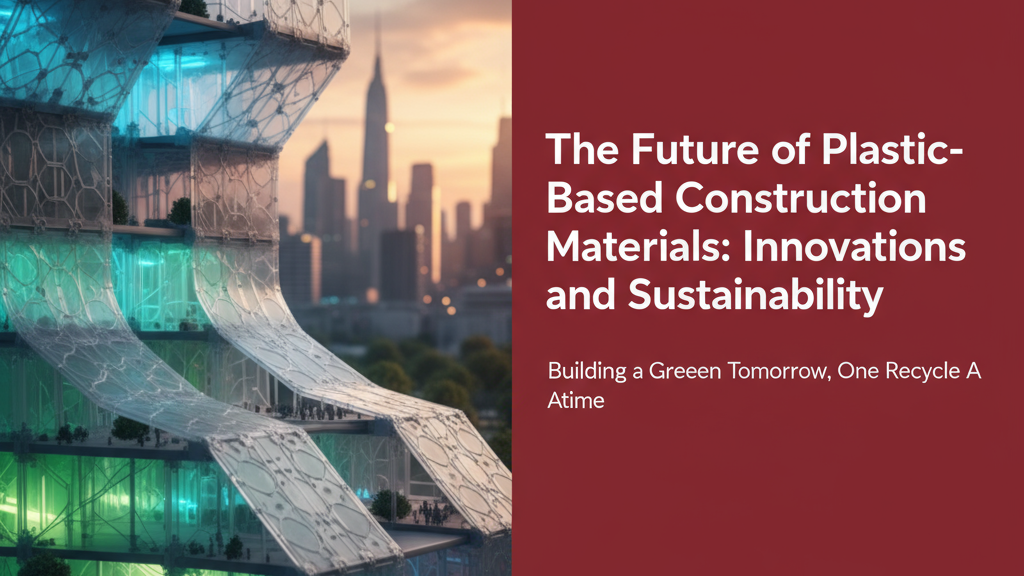Introduction to Plastic-Based Construction Materials
Plastic has become an integral part of modern construction, offering unique properties that traditional materials like wood, steel, and concrete often lack. From pipes and insulation to structural components, plastic-based materials are revolutionising the way buildings are designed and constructed. As the construction industry evolves, the focus on sustainability and innovation has brought plastic materials to the forefront of discussions about future building solutions.
Current Uses of Plastics in Construction
Plastic is already widely used in various construction applications:
- Piping Systems: HDPE and uPVC pipes are commonly used for plumbing, drainage, and irrigation due to their corrosion resistance and durability.
- Insulation: Expanded polystyrene (EPS) and polyurethane foam are popular for thermal and acoustic insulation.
- Windows and Doors: uPVC frames are favoured for their energy efficiency, low maintenance, and resistance to weather conditions.
- Flooring and Wall Panels: Vinyl and composite materials offer cost-effective and durable alternatives to traditional options.
Advantages of Plastic-Based Building Materials
Plastic materials bring several benefits to construction projects, making them a preferred choice for builders and architects alike.
Durability and Lightweight Properties
Plastic materials are known for their durability, resisting corrosion, rot, and pests. Their lightweight nature makes them easier to transport and install, reducing labour costs and construction time. For example, uPVC windows are significantly lighter than wooden or aluminium frames, yet they offer comparable strength and longevity.
Cost-Effectiveness and Versatility
Plastics are often more affordable than traditional materials, especially when factoring in long-term maintenance savings. Their versatility allows them to be moulded into various shapes and sizes, catering to diverse construction needs. HDPE pipes, for instance, can be designed to fit complex layouts while maintaining high performance.
Emerging Innovations in Plastic Construction
The construction industry is witnessing exciting innovations in plastic-based materials, paving the way for smarter and more sustainable building practices.
Recycled Plastic Building Blocks
One of the most promising advancements is the use of recycled plastic to create building blocks. These blocks are not only eco-friendly but also offer excellent insulation and structural integrity. Companies are experimenting with interlocking designs that eliminate the need for adhesives, making construction faster and more efficient.
Self-Healing Plastics
Self-healing plastics are another groundbreaking innovation. These materials can repair cracks or damage on their own, extending their lifespan and reducing maintenance costs. While still in the experimental phase, self-healing plastics hold immense potential for structural applications like bridges and buildings.
Sustainability and Environmental Impact
As the world moves towards sustainable construction, plastic materials are being re-evaluated for their environmental impact. While traditional plastics are derived from fossil fuels, advancements in recycling and biodegradable plastics are changing the narrative. For example:
- Recycling: Post-consumer plastic waste is being repurposed into construction materials, reducing landfill burden and conserving resources.
- Biodegradable Plastics: Researchers are developing plastics that break down naturally, minimising their environmental footprint.
- Energy Efficiency: Plastic-based materials like uPVC windows improve energy efficiency by reducing heat transfer, lowering carbon emissions in the long run.
Challenges and Future Prospects
Despite their benefits, plastic-based construction materials face several challenges:
- Perception: Plastics are often perceived as less durable or aesthetically appealing compared to traditional materials.
- Recycling Infrastructure: Inadequate recycling facilities in many regions limit the potential of recycled plastic materials.
- Regulatory Standards: Ensuring compliance with building codes and safety standards remains a priority for manufacturers.
However, ongoing research and development are addressing these challenges, making plastic materials a viable option for future construction.
Conclusion: The Road Ahead for Plastic in Construction
Plastic-based construction materials are poised to play a significant role in shaping the future of the building industry. With their durability, cost-effectiveness, and potential for sustainability, they offer innovative solutions to modern construction challenges. As technologies advance and recycling becomes more efficient, plastics will continue to evolve, paving the way for greener and smarter buildings. The road ahead is promising, and plastic is undoubtedly a key player in the journey towards sustainable construction.

